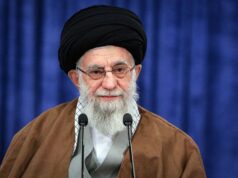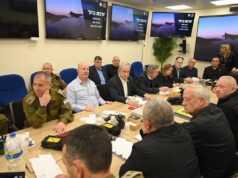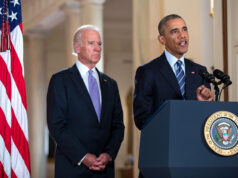When he takes office on January 20, 2009, the next president of the United States will have to contend with a range of pressing issues, from a global economic slowdown to soaring energy prices and a domestic housing market in crisis. On the foreign policy front, however, none will be as urgent as dealing with the persistent nuclear ambitions of the Islamic Republic of Iran. How the United States responds to Iran’s atomic drive will, to a large extent, dictate the shape of American strategy toward the greater Middle East for the foreseeable future.
The Downward Spiral
During his first term, President George W. Bush made clear that his administration “would not tolerate” a nuclear-armed Iran. But years of European and United Nations diplomacy have left Washington at the mercy of a convoluted and self-defeating diplomatic track—one with no clear end in sight. In the process, the goalposts have shifted in Tehran’s favor.
There can be no doubt that one of the principal culprits was the U.S. intelligence community’s latest National Intelligence Estimate on Iran. With its central claim that Iran had ceased work on nuclear weapons back in 2003, that document—released publicly in December 2007—profoundly undercut the Bush administration’s characterization of Iran as an imminent threat.
Washington has since steadily drifted toward détente with the Islamic Republic. It has announced plans to establish a formal diplomatic presence in Iran for the first time since the Iranian hostage crisis nearly three decades ago, implicitly accepting the idea of normalization. It has also thrown its weight behind a new negotiating proposal by the 5+1 group (made up of the United States, Russia, China, France, Great Britain and Germany). That offer, delivered to Tehran by E.U. foreign policy czar Javier Solana in mid-June, does not ask Iran to freeze its uranium enrichment entirely as a precondition to initiating preliminary dialogue.
Where does the United States go from here? The approaches of the two candidates now vying for the position of commander-in-chief are vastly different. As of yet, however, neither has articulated a comprehensive approach for dealing with Iran. Each will need to do so in short order. And when they do, their strategies should be informed by several broad realizations.
No Grand Bargain
Since the collapse of the Soviet Union nearly two decades ago, the United States has occupied the position of the world’s lone superpower. That status, however, has bred diplomatic hubris. U.S. policymakers now routinely expect everyone to want to talk to them, and for all items to be on the negotiating table when they do.
In the case of Iran, this may have been true back in 2003, when the regime put out feelers about the possibility of some sort of “grand bargain” with the United States. But this is decidedly not the case today. As Iran’s Supreme Leader Ayatollah Ali Khamenei stated in January, “[t]he conditions of the U.S. government are such now that it is harmful for us to resume relations.” Six months later, Iranian president Mahmoud Ahmadinejad told reporters that his government would not “retreat one iota” from its current nuclear effort.
If the words of Khamenei and Ahmadinejad are any indication, Iran does not view its nuclear program as a bargaining chip. Rather, it sees it as a staple of regime stability, and a vehicle for regional dominance. It perceives more benefit—and greater security—in moving ahead unilaterally on that front than in trying to hammer out some sort of negotiated settlement. This pours cold water on the hopes of either presidential candidate for a comprehensive deal with Iran.
“Ain’t Like the Last One”
Admiral Vern Clark, the legendary former U.S. Chief of Naval Operations, once famously remarked that America’s current conflict “ain’t like the last one, and it ain’t like the next one. It is like this one.” And yet, when it comes to predicting how Iran will behave when it crosses the nuclear threshold, U.S. policymakers seem determined to disregard this dictum. In their thinking about Iran, many come to the conclusion that, when it comes to nuclear weapons, Iran is just like the Soviet Union.
The attractiveness of the comparison is obvious. As commonly understood, deterrence involves a level of parity between two nuclear-armed states, creating a condition in which war becomes unthinkable because each has the power to obliterate the other. And, the thinking goes, since the United States is already a nuclear possessor, it does not actually have to do anything at all; this “balance of terror” will be established automatically just as soon as Iran gets the bomb.
But deterrence is about much more than simply nuclear possession. It involves clear lines of communication, an understanding of your adversary’s “red lines,” and most of all, a shared desire to avoid conflict. Notably, all of those things are missing in America’s current relationship with Iran. Save for recent tactical (and ultimately unconstructive) contacts over Iraq, the United States so far has had no formal dialogue with the Iranian government since the hostage crisis of 1979. As a result, American policymakers know far less than they should about Iran’s decision-making process, the personalities of its key leaders, and the regime’s fundamental principles and demands.
Finally, Iran’s leadership cannot be expected to behave in the same way the Soviet elites would have in the event of a crisis. As former CIA director James Woolsey has succinctly put it, the Soviets may have been radical, but they were rational, and they had no interest in dying for their dachas. Ahmadinejad and his ilk, however, are different. They believe that Iran is engaged in a civilizational war against the West that will bring about the second coming of the Islamic messiah—and they say so openly.
None of this, however, should be taken to mean that Iran’s leadership is irrational and millenarian. Far from it; several Iranian politicians (most notably former president and current Assembly of Experts and Expediency Council chairman Ali Akbar Hashemi Rafsanjani) are notoriously pragmatic. What it does suggest, however, is that at least one segment of the Iranian leadership is not seeking to avoid conflict with the West, but rather to precipitate one. And that demolishes the assumption that the next U.S. president can expect to successfully deter the Iranian regime under any conceivable conflict scenario.
The Iranian People: A Secret Weapon
Too often, Western policymakers view the Islamic Republic as a unitary actor, and ascribe the regime’s strategic objectives to the country as a whole. Nothing could be further from the truth. Iran today is a country in the midst of a profound socio-economic transition. Its population of 70 million is overwhelmingly young, while the clerical regime that came to power with the Islamic Revolution nearly three decades ago is graying and wrought with internal contradictions. Domestic conditions such as rampant unemployment, skyrocketing inflation, and a climbing poverty rate have contributed to a slackening of ideological bonds and made the regime increasingly unpopular.
The future of Iran, then, lies not with the current, sclerotic theocracy but with the country’s young, vibrant, and Westward-looking population. Washington has every interest in working with that constituency to make sure that when a domestic political transition does take place, it brings to power a more pluralistic, humane, and representative regime. Doing so, however, will require a far greater American investment in programs that promote grassroots democracy within Iran, and which constrain the way the Iranian regime relates to its own population.
So far, Washington has offered only nominal aid to those seeking freedom and pluralism within the Islamic Republic. Nor has it worked to increase international attention to—and punishment of—Iran’s repressive domestic practices, even though constraining Iran’s ability to oppress its own population is a necessary prerequisite for the creation of the “empty political space” in which real regime alternatives can flourish. Our next president will need to harness the forces of change now stirring within Iran. At the same time, he will need to avoid expedient short-term diplomatic deals that could extend the lifespan of the current regime at the expense of more democratic alternatives.
From the Chinese Playbook
Armed with a nuclear capability, the Iranian regime will have far greater leeway to suppress opposition at home without having to fear retribution from abroad. The Iranian leadership understands this reality all too well, and is acting upon it. Since taking office in August 2005, Ahmadinejad has launched a domestic “cultural revolution” that includes a massive clampdown on Iran’s already endangered free media, expanded governmental interference in social and cultural matters, and extensive restrictions on the ability of Iranians to access the Internet. Tellingly, the scope and intensity of this offensive tracks closely with Iran’s progress on the nuclear front, indicating that the Iranian regime views its nuclear program in part as a vehicle to squelch dissent by its domestic opponents; progress on the former is directly correlated with greater pressure on the latter.
In this sense, the Iranian regime has taken a page from the playbook of the Chinese Communist Party, whose brutal crackdown on student protests in Tiananmen Square in 1989 earned it international condemnation but no lasting consequences. The end result of Iranian nuclearization, therefore, is likely to be the demise of Iran’s nascent political opposition, and a dramatically longer lifespan for the current regime in Tehran.
Subcontracting is Not a Strategy
Ever since news of Iran’s nuclear program broke into the open in the fall of 2002, the international community has been attempting to coax Iran into adopting a more constructive stance over its atomic effort. As a practical matter, the United States has consistently taken a back seat in this process. Rather than articulate an independent strategy for dealing with Iran’s nuclear program, it has ceded the initiative first to the EU-3 (Great Britain, France, and Germany) and then to the United Nations Security Council, with predictable results.
Today, the United States is doing much the same with Israel. Faced with Tehran’s relentless march toward the bomb, numerous policymakers have pinned their hopes on a potential Israeli military strike as the panacea to their nagging Iran problem. Such action may indeed be in the offing; Israeli officials have said that a nuclear Iran would represent the single greatest threat to the Jewish state since its founding in 1948. But the goals of such an offensive are likely to be limited—a simple delay of Iran’s nuclear capability, rather than its outright destruction, and certainly not the more expansive action necessary to alter the character of the Iranian regime. The next president must think carefully about whether such a limited agenda truly satisfies long-term American strategic objectives. If he decides that it does not, he must identify what else can and should be done.
Moment of Truth
While the current administration may leave office without resolving the Iranian nuclear challenge, the next American president will almost certainly not have that luxury. Irrespective of his political affiliation or views about the Islamic Republic, the future occupant of 1600 Pennsylvania Avenue will be forced to prevent Iran from getting the bomb—or craft a new regional posture in the aftermath of action by a country that has.
The stakes could not be higher. If Iran gets the bomb, it will have a dramatically greater regional reach. Iran’s leaders know this. In April, surveying his regime’s atomic accomplishments on the occasion of Iran’s second national “nuclear day,” Ahmadinejad told supporters that Iran’s nuclear effort “is the most important political development in contemporary history,” and that “victory in this biggest political battle will lead to new international developments.”
This must not be acceptable to either candidate.
Ilan Berman is vice president for policy at the American Foreign Policy Council. A longer version of this piece appears in the Fall 2008 edition of The Journal of International Security Affairs.





